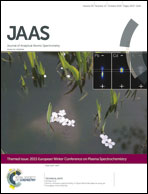Measurement of arsenic species in environmental, biological fluids and food samples by HPLC-ICPMS and HPLC-HG-AFS†
Abstract
The importance of measuring arsenic (As) species has been appreciated for a long time mainly because of the wide spread knowledge of arsenic's toxicity and its use as a poison. Increasingly health, environmental and food regulations have been written around As species rather than total concentrations. Knowledge of As speciation is important as the chemical form of As controls its bioavailability, toxicity, mobility and therapeutic benefits. Arsenic is present as inorganic (arsenate, arsenite, thioarsenates), complexed (arsenic glutathionines and phytochelatins), low molecular weight (monomethylarsonate, dimethylarsenate, arsenobetaine, arsenocholine etc.) and high molecular weight (arsenic hydrocarbons and arsenic phospholipids) species. In this review we cover the intergrity of As species during collection, storage, sample preparation and measurement by HPLC-ICPMS and HPLC-HG-AFS. It is essential to ensure that As species, especially in waters and sediments, are not artefacts of the preservation or extraction procedure. Most samples can be stored frozen (−20 °C), but the stability of water and sediment samples is matrix dependent and depends on preservation technique applied. Arsenic cannot be extracted from samples using a single set of conditions but must be optimised for each sample type. Methanol–water mixtures with microwave heating are commonly used to extract polar As species from tissues while As-lipids required a non-polar solvent. Dilute acid can be used to increase the efficiencies of extraction of hard to extract tissue As species. Freeze drying is suitable for the drying of biotic material while sediments should not be dried before analysis. Extraction efficiencies are critically dependent on particle size. Polar As species have a wide variety of ionic characteristics thus complimentary chromatographic approaches utilising ion-exchange or reverse phase columns with modifiers are needed to separate all the As species. Arsenic-lipids require the use of a reverse phase column and gradient elution with high concentrations of organic solvents and require compensation for carbon enhancement effects in the ICPMS. Care must be taken that chromatographic peaks are not misidentified and matrix interferences accounted for that may influence quantification. Finally, to ensure accurate results, mass balances and extraction and column recoveries need to be determined at all steps. Methods need to be evaluated using As spikes and certified reference materials to provide a means of assessing the quality of results.


 Please wait while we load your content...
Please wait while we load your content...